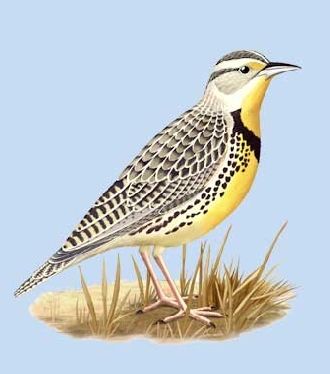
Short, stocky, ground-dwelling
bird with dark-streaked brown upperparts and bright yellow underparts
with broad black V on breast. Crown is dark brown-and-white striped;
face is white with dark eyestripes. Bill is sharply pointed. Tail is
brown with white edges. Forages on ground.

|
WESTERN
MEADOWLARK
Sturnella neglecta
PASSERIFORMES
Blackbirds and Orioles (Icteridae)
Range
and Habitat
Breeds from British Columbia, Manitoba, northern Michigan,
and northwestern Ohio south to Missouri, central Texas, and northern
Mexico; has spread eastward in recent years. Spends winters in much
of its breeding range north to southern British Columbia, Utah, and
Arkansas. Preferred habitats include meadows, plains, and prairies.
SOUND:
"shee-oo-e-lee shee-ee le-ee"
The Western
Meadowlark was first described in 1844 by Audubon. Although it looks
nearly identical to the Eastern Meadowlark, the two species rarely hybridize.
Mixed pairs usually occur only at the edge of the range where few mates
are available.
A male usually has two mates at the same time.
The females do all the incubation and brooding,
and most of the feeding of the young.
A group of meadowlarks are collectively known
as a "pod" of meadowlarks.

The Western Meadowlark
is a medium blackbird that looks much like the Eastern Meadowlark. Preferred
breeding habitats include grasslands, prairies and open fields. Their
range extends from central North America to northern Mexico. Nests are
built on the ground and covered with a roof made of grass, making them
well-camouflaged. Northern populations will migrate during winter months
to the southern portion of their range.
Food is foraged on the ground, and typically includes insects, seeds
and berries. This is also the state bird of Kansas, Montana, Nebraska,
North Dakota, Oregon and Wyoming.
|




